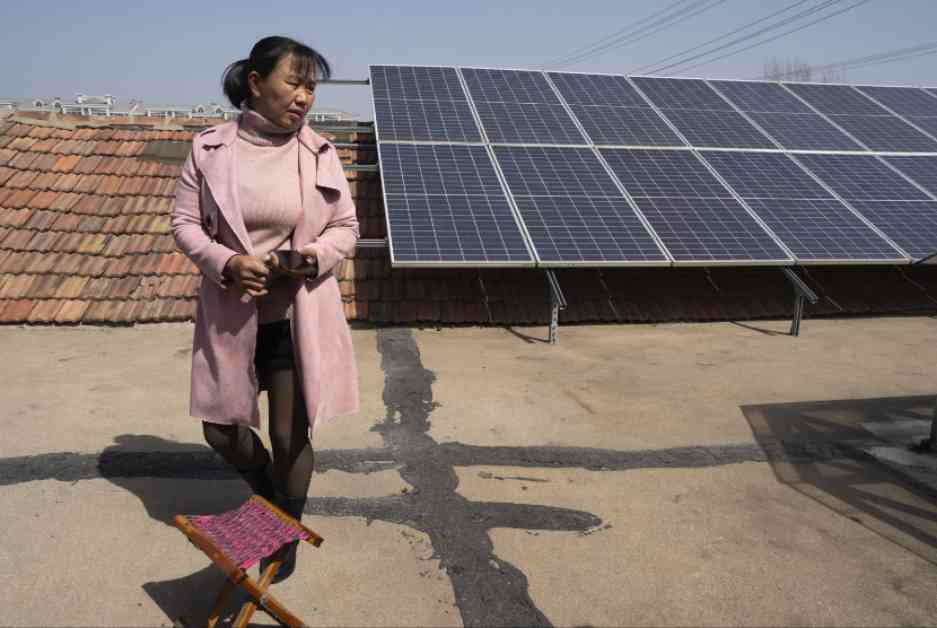China Slashes Subsidies for Renewable Energy Projects
Shi Mei, a Chinese farmer, strolls near solar panels on the roof of her rural home in Jinan, Shandong Province, China, on March 21, 2024. The National Development and Reform Commission (NDRC), China’s economic planning body, has announced plans to reduce subsidies for renewable energy projects. This decision comes on the heels of China’s significant increase in wind and solar power installations last year.
In 2024, China broke its own records for wind and solar power development. The capacity of these two renewable energies surged by 45% compared to the previous year. According to the Renewable Energy Industry Association (REIA) data, China has installed 887 gigawatts of solar power, six times more than the United States. This leap helped China achieve its 2030 target six years ahead of schedule.
The NDRC stated that in collaboration with China’s energy agencies, they are shifting towards market-oriented policies to support clean energy projects. Currently, 40% of China’s total power generation capacity comes from clean energy sources, largely due to a system that guarantees the sale of renewable energy to the grid.
“We have seen a significant decrease in the costs of renewable energy development compared to its early stages,” NDRC mentioned in a statement on Sunday, February 9, 2025. New projects completed by June this year will now have to pay electricity tariffs based on market-based auction prices. The NDRC estimates that this change will not affect households or agriculture.
The commission highlighted their intention to collaborate with all local governments to implement these plans. However, they did not disclose the specific formula for determining the new prices. The reduction in subsidies for solar power plants will put additional pressure on China’s solar industry. The increased capacity compared to global demand has lowered solar panel prices and poses a threat to small solar panel manufacturers.
Expert Insights and Future Implications
Expert Analysis: Impact on the Global Renewable Energy Market
Renowned energy analyst, Dr. Li Wei, shared his insights on the implications of China’s subsidy cuts on the global renewable energy market. According to Dr. Wei, while the decrease in subsidies may initially pose challenges for Chinese solar companies, it could lead to a more competitive market in the long run. He emphasized the importance of innovation and cost-efficiency in sustaining the growth of renewable energy industries worldwide.
With China being a major player in renewable energy development, the changes in subsidy policies are closely monitored by industry experts and environmental advocates. The shift towards market-driven pricing reflects a broader trend towards sustainability and market competitiveness in the renewable energy sector.
Local Impact: Perspectives from a Chinese Solar Panel Manufacturer
Zhang Wei, the owner of a small solar panel manufacturing company in Shandong Province, expressed his concerns about the subsidy reductions. He highlighted the challenges faced by local manufacturers in staying afloat amidst the changing market dynamics. However, Zhang also acknowledged the need for innovation and adaptation to thrive in the evolving renewable energy landscape.
As China navigates the transition towards market-oriented renewable energy policies, the local impact on small businesses and consumers remains a focal point of discussion. The resilience and adaptability of Chinese industry players will play a crucial role in shaping the future of renewable energy development in the country.
In conclusion, China’s decision to reduce subsidies for renewable energy projects marks a significant shift towards market-driven pricing and sustainability in the sector. While challenges lie ahead for the solar industry, the long-term benefits of a more competitive market and enhanced innovation hold promise for the global renewable energy landscape. As China continues to lead in renewable energy development, the world watches closely to see the outcomes of these policy changes and their impact on the future of clean energy.














